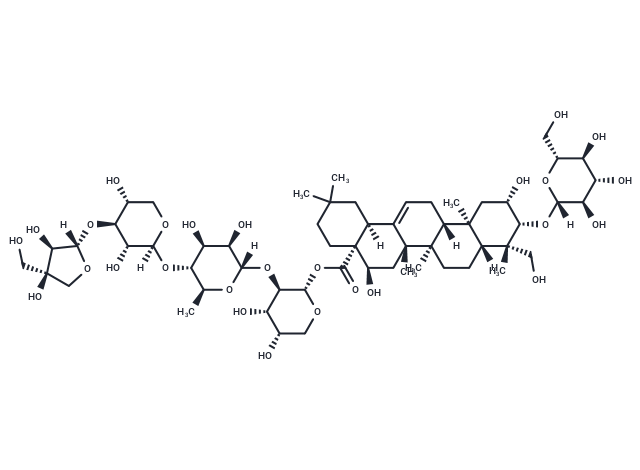Shopping Cart
- Remove All
 Your shopping cart is currently empty
Your shopping cart is currently empty

Polygalacin D shows anti- proliferation, anti-inflammary, and hepatoprotective activities, it can inhibit the expression of lipopolysaccharide (LPS)-induced iNOS and COX-2 protein and mRNA without an appreciable cytotoxic effect on RAW 264.7 macrophages, and can suppress induction by LPS of pro-inflammatory cytokines such as prostaglandin E2 (PGE2).

| Pack Size | Price | Availability | Quantity |
|---|---|---|---|
| 1 mg | $123 | In Stock | |
| 5 mg | $360 | In Stock | |
| 10 mg | $543 | In Stock | |
| 25 mg | $879 | In Stock | |
| 50 mg | $1,180 | Backorder |
| Description | Polygalacin D shows anti- proliferation, anti-inflammary, and hepatoprotective activities, it can inhibit the expression of lipopolysaccharide (LPS)-induced iNOS and COX-2 protein and mRNA without an appreciable cytotoxic effect on RAW 264.7 macrophages, and can suppress induction by LPS of pro-inflammatory cytokines such as prostaglandin E2 (PGE2). |
| In vitro | In this study, we investigated the effects of seven platycodin saponins on the activities of inducible nitric oxide synthase (iNOS) and cyclooxygenase II (COX-2) in lipopolysaccharide (LPS)-induced RAW 264.7 macrophages. We found that 2'-O-acetyl Polygalacin D (S1), platycodin A (S2), platycodin D (S3), and Polygalacin D (S6) inhibited LPS-induced NO production in a concentration-dependent manner. Furthermore, these compounds inhibited the expression of LPS-induced iNOS and COX-2 protein and mRNA without an appreciable cytotoxic effect on RAW 264.7 macrophages, and could suppress induction by LPS of pro-inflammatory cytokines such as prostaglandin E2 (PGE2). Treatment with these compounds of RAW 264.7 cells transfected with a reporter construct indicated a reduced level of LPS-induced nuclear factor-kappaB (NF-kappaB) activity and effectively lowered NF-kappaB binding as measured by electrophoretic mobility shift assay (EMSA). The suppression of NF-kappaB activation appears to occur through the prevention of inhibitor kappaB (IkappaB) degradation. In vivo, platycodin saponin mixture (PS) and S3 protected mice from the lethal effects of LPS. The 89% lethality induced by LPS/galactosamine was reduced to 60% and 50% when PS and S3, respectively, were administered simultaneously with LPS[1] |
| Molecular Weight | 1209.4 |
| Formula | C57H92O27 |
| Cas No. | 66663-91-0 |
| Smiles | [H][C@@]1(O[C@H]2[C@H](O)CO[C@@]([H])(O[C@H]3[C@H](C)O[C@@]([H])(O[C@@H]4[C@@H](O)[C@@H](O)CO[C@H]4OC(=O)[C@]45CCC(C)(C)C[C@@]4([H])C4=CC[C@]6([H])[C@@]7(C)C[C@H](O)[C@H](O[C@]8([H])O[C@H](CO)[C@@H](O)[C@H](O)[C@H]8O)[C@](C)(CO)[C@]7([H])CC[C@@]6(C)[C@]4(C)C[C@H]5O)[C@H](O)[C@@H]3O)[C@@H]2O)OC[C@](O)(CO)[C@H]1O |
| Relative Density. | 1.54 g/cm3 at 20℃ |
| Storage | keep away from direct sunlight,keep away from moisture | Powder: -20°C for 3 years | In solvent: -80°C for 1 year | Shipping with blue ice. | |||||||||||||||||||||||||
| Solubility Information | DMSO: 55 mg/mL (45.48 mM), Sonication is recommended. | |||||||||||||||||||||||||
Solution Preparation Table | ||||||||||||||||||||||||||
DMSO
| ||||||||||||||||||||||||||

Copyright © 2015-2025 TargetMol Chemicals Inc. All Rights Reserved.